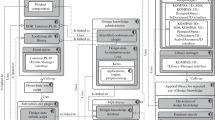Abstract
Although many attempts have been made to enable creative and effective design activities using a computer, many design activities depend on the designer’s personal ability and are learned through interpersonal communication. These limitations are thought to be due to the fact that the knowledge we use does not cover the entire design process, comprising the problem-forming process and the problem-solving process, in a systematic manner. In this study, a method of dealing with the design information, in which the problem-forming process is considered, and dealt with simultaneously the problem-solving process, is proposed. This method is composed of three steps: (1) determination of the evaluation function from the shape, (2) synthesis (composition) of the evaluation function, and (3) generation of the shape candidates from the evaluation function. Interaction with a computer system implementing this method is expected to assist the shape design at an early stage. In this study, this method is developed and realized in a computer system.
Access this chapter
Tax calculation will be finalised at checkout
Purchases are for personal use only
Preview
Unable to display preview. Download preview PDF.
Similar content being viewed by others
References
Chapman, CD and Jakiela, NU: 1994, Genetic algorithm-based structural topology design with compliance and manufacturability considerations, Journal of Mechanical Design 118: 89–98.
Finke, RA, Ward TB and Smith SM: 1992, Creative Cognition, The MIT Press, Cambridge, MA.
Gero, JS: 1996,:Creativity,emergence and evolution in design, Knowledge-Based Systems 9: 435–448.
Koza, J: 1992, Genetic Programming, On the Programming of Computers by means of Natural Selection, MIT Press, Cambridge, MA.
Ludy, SC, Dixon, JR and Simmons, MK: 1986, Designing with features: creating and using a feature database for evaluation of manufacturability of castings, ASME Computers in Engineering Conference, ASME, New York, pp. 285–293.
Paul, G and Beitz W: 1997, Engineering Design, Springer Verlag, Berlin.
Suwa, M and Tversky, B: 1996, What architects see in their design sketches: implications for design tools, Human Factors in Computing Systems: CHI’96 Conference Companion, ACM, New York, pp. 191–192
Suwa, M and Tversky, B: 1997, What do architects and students perceive in their design sketches?: A protocol analysis, Design Studies 18 (4): 385–403
Takeda, H, Veerkamp, P, Tomiyama, T and Yoshikawa, H: 1990, Modeling design processes, AI Magazine, 11 (4): 37–48.
Taura, T, Yoshimi, T and Ikai, T: 2002, Study of gazing points in design situation–a proposal and practice of an analytical method based on the explanation of design activities, Design Studies 23 (2): 165–185.
Tutiya,T: 1993, Is the Science of Mind Possible?, University of Tokyo Press, Tokyo.
Tversky, A and Kahneman, D: 1981, The framing of decisions and psychology of choice, Science, 211: 453–458
Ulrich, KT and Eppinger, SD: 1995, Industrial Design, Product Design and Development, McGraw-Hill, New York.
Weisberg, RW: 1992, Creative Problem Solving, Creativity-Beyond the Myth of Genius, WH.Freeman and Company, New York.
Yoshimi, T and Taura, T, A: 1999, Computational model of a viewpoint-forming process in a hierarchical classifier system, Genetic Programming 1999: Proceedings of the Fourth Annual Genetic Programming Conference,Morgan Kaufmann, San Fransisco, pp. 758–766.
Author information
Authors and Affiliations
Editor information
Editors and Affiliations
Rights and permissions
Copyright information
© 2002 Springer Science+Business Media Dordrecht
About this chapter
Cite this chapter
Taura, T., Shiose, T., Ishida, R. (2002). Strategic Shape Design. In: Gero, J.S. (eds) Artificial Intelligence in Design ’02. Springer, Dordrecht. https://doi.org/10.1007/978-94-017-0795-4_18
Download citation
DOI: https://doi.org/10.1007/978-94-017-0795-4_18
Publisher Name: Springer, Dordrecht
Print ISBN: 978-90-481-6059-4
Online ISBN: 978-94-017-0795-4
eBook Packages: Springer Book Archive




